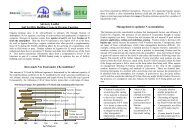Green Manures booklet - Institute of Organic Training and Advice
Green Manures booklet - Institute of Organic Training and Advice
Green Manures booklet - Institute of Organic Training and Advice
Create successful ePaper yourself
Turn your PDF publications into a flip-book with our unique Google optimized e-Paper software.
Crimson clover or Italian clover (Trifolium incarnatum)<br />
The use <strong>of</strong> green manures<br />
Suitability:<br />
L<br />
pH range preferred:<br />
5.5-7.0<br />
Height:<br />
30-60 cm<br />
Frost tolerance:<br />
Good<br />
Subterranean clover (Trifolium subterraneum)<br />
Suitability:<br />
I<br />
pH range preferred:<br />
5.5-7.0<br />
Height:<br />
20 cm<br />
Frost tolerance:<br />
Good<br />
OTHER CLOVERS:<br />
This is characterised by brilliantly coloured flowers. It is<br />
an annual <strong>and</strong> does not recover after grazing or cutting <strong>and</strong><br />
gives lower yields than red clover although it may be<br />
established later in the autumn since its seeds are<br />
relatively large.<br />
This is a prostrate plant with long branched creeping<br />
stems. It may be particularly suitable for intercropping.<br />
The flowers (self pollinated) are pushed into the soil; the<br />
plant then dies <strong>of</strong>f but regenerates the following year<br />
(possibly causing a weed problem).<br />
Alsike clover (Trifolium hybridum). Despite its name this is not a hybrid. It is <strong>of</strong> Sc<strong>and</strong>inavian origin <strong>and</strong> is<br />
better adapted than white or red clover to wet acid soils <strong>and</strong> cool conditions although under more favourable<br />
circumstances it will not yield as well. Its growth habit it is similar to red clover.<br />
Strawberry clover (Trifolium fragiferum) is similar to white clover but has better autumn <strong>and</strong> winter growth <strong>and</strong><br />
is tolerant <strong>of</strong> wet <strong>and</strong> salty soils.<br />
Yellow suckling clover (Trifolium dubium) is a common contaminant <strong>of</strong> white clover seed but is much less<br />
productive <strong>and</strong> persistent.<br />
Rose clover (Trifolium hirtum). Like subterranean clover this produces most <strong>of</strong> its growth in the spring following<br />
autumn germination <strong>and</strong> slow growth overwinter. It may be useful in conditions <strong>of</strong> low fertility <strong>and</strong> rainfall.<br />
Caucasian clover (Trifolium ambigium) is a persistent pasture plant <strong>of</strong> cool climates although it remains<br />
dormant over the winter <strong>and</strong> is slow to grow in spring. It tolerates waterlogged conditions <strong>and</strong> is superior to<br />
white clover at low pH <strong>and</strong> phosphate levels.<br />
Berseem or Egyptian clover (Trifolium alex<strong>and</strong>rinium) <strong>and</strong> Persian clover (Trifolium resupinatum) are annuals<br />
really requiring warmer temperatures than those <strong>of</strong> the UK although they may give reasonable yields during the<br />
summer months.<br />
MEDICS (Medicago spp.) are another important genus <strong>of</strong> legumes. They have trifoliate leaves <strong>and</strong> so appear<br />
superficially similar to clovers but can be distinguished because the midrib projects beyond the leaf margin.<br />
6




